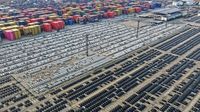The global economic landscape in August 2025 is being sharply reshaped by the United States’ aggressive tariff policies, spearheaded by President Donald Trump. As the U.S. slaps hefty duties on imports from major trading partners, the ripple effects are felt far beyond American shores, with China and India facing particularly challenging headwinds. The world is watching closely as these economic giants recalibrate strategies, and the consequences are proving to be as complex as they are far-reaching.
In the United States, the immediate impact of Trump’s tariffs has been less dramatic than initially feared—at least when it comes to the sticker price on consumer goods. According to Capital Economics, U.S. tariffs have not hiked prices as much as expected, but inflation is nonetheless ticking higher. The consumer price index (CPI) rose at an annual rate of 2.7% in July 2025, just shy of the 2.8% forecast and unchanged from June’s pace. More tellingly, the core CPI—which strips out volatile food and energy costs—accelerated to 3.1% from 2.9% the previous month. As Capital Economics notes, the full force of tariff impacts is likely to ramp up through the rest of the year, potentially complicating the Federal Reserve’s plans for any interest rate cuts.
“With many trade deals agreed, there is now greater certainty about where tariffs will end up, which should allow retailers to finally raise their prices,” wrote Simon MacAdam and Ariane Curtis of Capital Economics in a recent note. So far, American retailers have absorbed much of the tariff burden by sacrificing their profit margins, but as clarity emerges on the future of tariffs, that buffer may soon vanish. Surveys show that U.S. companies have already experienced significant cost hikes—unlike their counterparts abroad.
Globally, the story is nuanced. While American consumers face the prospect of rising prices, the rest of the world might experience a mild reprieve. Most countries have not retaliated against U.S. tariffs with their own, and some have even reduced duties on American goods. For instance, Indonesia agreed to eliminate tariffs on nearly all U.S. imports as part of a recent deal, even as the U.S. imposed a 19% duty on Indonesian goods. This dynamic, Capital Economics suggests, could introduce a slightly disinflationary effect worldwide, as global demand softens and Chinese exports are redirected from the U.S. to other markets, potentially lowering import prices elsewhere.
China, however, is facing a markedly different scenario. As reported by Bloomberg, July 2025 marked the nation’s worst economic slowdown of the year. Fixed-asset investment plummeted about 5.3% year-on-year—the steepest drop since the onset of the Covid-19 pandemic in early 2020. Industrial activity growth hit an eight-month low, and retail sales grew at their slowest pace since December 2024. Private companies reported the worst contraction in investment since September 2020 during the first seven months of 2025, and capital expenditure by manufacturers grew at the slowest pace in over a year.
“It does seem like the U.S. tariffs are just starting to bite,” Duncan Wrigley, chief China economist at Pantheon Economics, told Bloomberg. He noted that while domestic demand remains sluggish, China has been holding back on major stimulus measures, reserving them for when export slowdowns become more acute. Beijing’s campaign to curb overcapacity and a crackdown on destructive price wars have compounded these challenges, particularly in sectors like batteries and solar panels.
The People’s Bank of China is widely expected to further ease monetary policy as soon as September 2025 in response to the slowdown. Modest measures have already been announced, such as subsidizing part of the interest payments on consumer loans. Still, the government’s existing fiscal stimulus has provided only limited relief, partly due to temporary funding shortages and extreme weather delaying infrastructure projects. According to the National Bureau of Statistics, “continued impact of trade protectionism and unilateralism” has weighed heavily on economic activity.
China’s export machine, once a reliable engine of growth, is now sputtering. Exports to the U.S. have dropped sharply, and overall export growth slowed to just 0.2% month-on-month in July, down from 0.4% in June. Robin Brooks, a senior fellow at the Brookings Institution, explained that China is increasingly transshipping goods through third countries to circumvent U.S. tariffs—a costly maneuver that eats into profits and adds logistical headaches. “For a country like China, which is massively export-dependent and already teetering on deflation, that’s a worrying prospect,” Brooks wrote.
India, meanwhile, is grappling with its own set of daunting challenges. The U.S. has imposed a steep 50% country-specific tariff on most Indian goods, on top of existing duties, as a penalty for India’s purchases of Russian crude oil and military equipment. The Global Trade Research Initiative (GTRI) estimates that these tariffs could cost India around $50 billion in lost exports, with only $10 to $15 billion potentially recoverable in the first two years through market diversification to Europe, ASEAN, Africa, the Middle East, and Latin America.
Ajay Srivastava, GTRI’s founder, outlined India’s limited options: negotiate with the U.S., retaliate with tariffs of its own, diversify export markets, or offer concessions such as halting Russian oil imports to secure tariff relief. “Each option carries a different mix of gains and risks,” Srivastava told PTI. He also suggested that India “quietly highlight the tariffs’ cost to American voters,” arguing that higher prices and unemployment in the U.S. might prompt Washington to eventually lower duties to around 15% for all countries. “In an era when economic power is used as a weapon, survival isn’t about avoiding confrontation. It’s about picking the right battles, anticipating the next move, and playing for the long win,” Srivastava added.
The tariffs—25% from August 7 and another 25% from August 27—are expected to slash exports of key Indian products such as shrimp, apparel, organic chemicals, and jewelry by 50% to 70%. Despite these tensions, bilateral trade talks are ongoing, with the next round scheduled for August 25. Both sides are aiming to conclude the first phase of a trade agreement by September or October and have set an ambitious goal of doubling bilateral trade to $500 billion by 2030, up from $191 billion today.
As the world’s largest economies jockey for advantage in a landscape marred by protectionism and uncertainty, the stakes could hardly be higher. The coming months will test the resilience of global supply chains, the adaptability of policymakers, and the patience of consumers everywhere. The only certainty is that the tariff wars of 2025 are far from over, and their outcome will shape economic fortunes for years to come.


